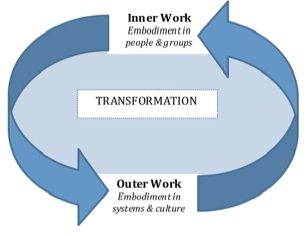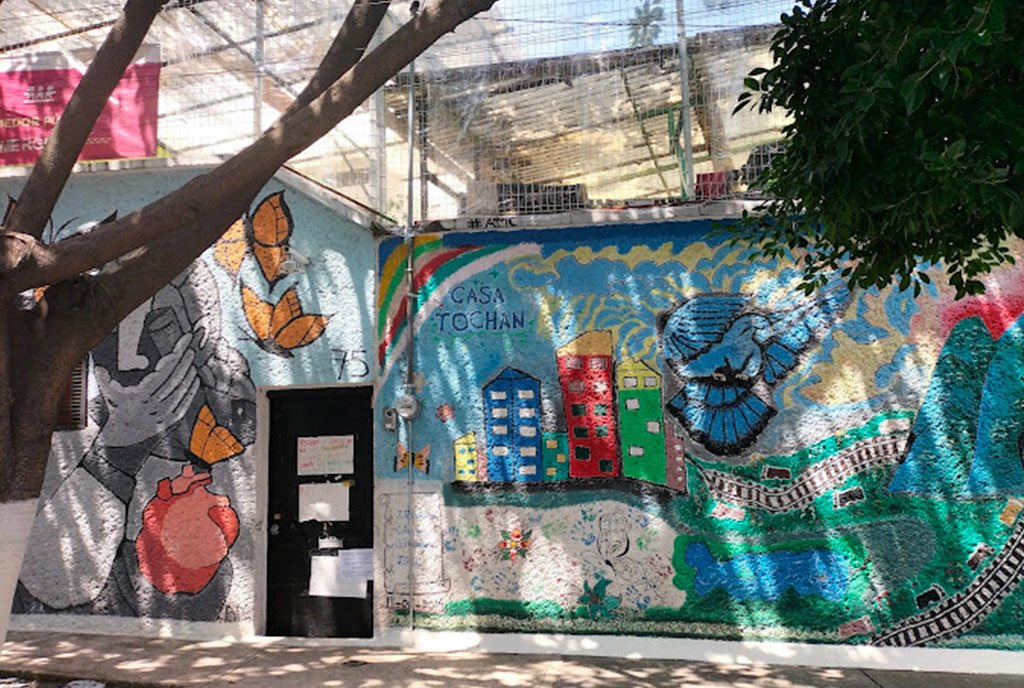
The Management Assistance Group (MAG) is one of NPQ’s go-to sources of information about social justice movements. MAG works with a number of the networks that are moving some of this nation’s most difficult issues. MAG has come to believe there are five elements that are critical to advancing a thriving justice ecosystem. This concludes a special five-part series, in which MAG and NPQ invite you to contribute to the evolution of what these elements mean in practice.
“Pause what you’re doing for a moment. Take a deep breath. In. And out. Now, take an honest and loving look at yourself. How are you? How are you feeling—literally, how is your body feeling? Are you well rested and energized, or tired, drained, stressed out? Take another breath… Are you living the life you intend, the life that will truly change the world? Or are you slowly destroying yourself in the name of doing good?”
Gita Gulati-Partee, founder and president of OpenSource Leadership Strategies, asked that inconvenient question that many of us in “the business of change” face at some point: To what degree are our work and the ways we live our lives transforming the world, and to what degree are we unconsciously working against ourselves and our deepest vision?
A story told by Scott Nine, who heads the Initiative for Collaborative Governance in Education of the National Policy Consensus Center, also illustrates this paradox.1 Nine describes how, after a series of painful events, “I paused to reflect on myself. I saw how up in my head I was, how I was totally gripped by my work. I didn’t realize how empty I’d gotten—that I had little to no reserves. Or, as a friend told me, I needed to come home to myself.”
Reintroduced to “inner work” at a gathering of activists, Scott began to intentionally change his daily routine, weaving in practices that reconnected him to himself and the things most important to him.
I used to wake up and immediately look at my cell phone for emails and news. Now I don’t look at my cell phone for the first 30 minutes of the day. For 15 minutes, I stay quiet and notice what’s in my head and focus on my breathing. I let myself come to alertness that way. Going to bed used to be all about social media and email. Now, I’ve turned that off. I focus on gratitude as I go to bed. I do that with my kids too and it has changed how they go to bed.
These practices also began to have a profound impact on his work.
What I see is possible in a group has also changed. I’ve seen over and over that how people enter into and hold a space is more important than process mechanics. People are able to drop down to core issues and truths much faster, and so much more can be accomplished…
Scott and Gita’s reflections speak to deeply human desires and needs. A need for human connection and relationship—connection to ourselves and with one another. A desire in our work for synergistic vision and movement, within and across our organizations. A desire for meaning and impact.
The “justice ecosystem” refers to those individuals, organizations, and networks across sectors that care about sharing resources and power in just ways. Many people across the justice ecosystem are intensely reflecting on what will make their work meaningful, impactful, and ultimately transformative. Of the emerging insights, many are finding answers in the vital connection between inner work—transforming ourselves—and outer work, or transforming the world. As Ai-jen Poo, director of the National Domestic Workers Alliance (NDWA), said, “If we are going to create any meaningful change, we must model new relationships to ourselves and the world around us.”2
Inner Work and Outer Work: A Framework for Holistic Social Transformation
In our work with leaders, organizations, and networks, we have observed that the more we are able to connect to our deepest purpose (the core of who we are, what we are doing and why) and our “source” (knowing we are part of something larger than ourselves) and align with others in that spirit, the greater chance we have of:
- Continually refueling and replenishing our reserves when they are low and we are depleted (or not letting ourselves get depleted);
- Skillfully allowing and channeling the transformative energy of emotions (including love, joy, anger, and others) that can aid or hinder our ability to connect with ourselves and one another, re-ground in our individual and collective core purpose, and buoy timely, skillful action; and
- Increasing our synergy, alignment, and collective strategy and action, including healing rifts inside ourselves, our organizations, and our networks and movements.
As human beings, we all want these things. Scott, Gita, and others are helping us see how essential inner work and the practices that support it are, both for our own wellbeing and for our ability to do the “outer work” of social transformation and justice.
In the context of generating thriving justice ecosystems, inner work may be one of the least discussed but most essential elements. An ecosystem depends on the strength, vitality, and connection between its members. Like the cells in a body or the trees in a forest, the wellbeing and agency of the whole fundamentally depends on the wellbeing of its members. Similarly, our ability to create meaningful change as an “ecosystem” depends on our ability to embody and reflect the transformation we wish to see inside ourselves at the same time we embody it in the systems around us. This relationship between inner and outer change is generative. The more we nurture and experience change in one, the more we long for and believe it can be so in the other.

Inner work also helps us to generate the qualities and conditions necessary for other essential elements of transformative systems change, which Management Assistance Group (MAG) talks about as including: accessing multiple ways of knowing, embodying deep equity, influencing complex systems, and nurturing leaderful ecosystems.
Framework for Inner Work and Social Transformation

The deep connection between inner and outer work has taken on new urgency for us in the weeks following Donald Trump’s election. We see the need for deep change all around us—change that transcends binaries, heals hearts and minds, and transforms systems and structures—but how do we get there? We are finding that a primary key to lasting social transformation and justice may actually be our own inner work.
We share this article to help the field open and deepen its dialogue, understanding, and sharing of approaches to inner work—both the individual practices that support transformation, sustenance, and healing, and the group practices that lead to clarity of purpose, deepened alignment, healthier relationships, more powerful strategy, and sustainability for the long haul of social change—and its relationship to social transformation.
The Practices of Inner Work
By “practice,” we mean the conscious ongoing use of tools, techniques, and traditions that connect us back to our source and core essence, to our motivation, to each other, to the world, and to our deepest purpose for our work and being on the planet. Inner work practice is the “work” we do within ourselves and within our in our organizations, movements, networks, boardrooms, meeting rooms, community centers, spiritual centers, and offices to embody ways of being that align with and generate the world we long for. These practices help us ground and anchor so deeply in our core being (including purpose, commitments, values and other areas), that the deeper our practice becomes, the less likely it is possible for us to be shaken out of it, no matter the outer conditions or circumstances.
Individuals can use a variety of personal inner work practices, such as hiking, gardening, jogging, artistic endeavors, dancing, singing, meditation, swimming, prayer, ceremony, yoga, or martial arts to renew, ground, and find connection in themselves. These practices may be silent, loud, physical, reflective, artistic, ceremonial, or any number of other approaches. Groups (a team, organization, community, network, alliance, etc.) can also use collective practices to ground themselves in their shared purpose, develop culture and structures that reflect their core values, and increase their alignment, synergy, and impact.
Some in the field are beginning to experience and name significant impacts from integrating individual and group practice, including more patience with ourselves and others, more resilience in the face of adversity, greater awareness and compassion in our perception, the ability to hold multiple perspectives, and readiness to partner with others across differences. These results help us to know that whatever our practices are, they are yielding positive fruit.
At their most potent, these practices are inseparable from our work in the world. Rather, they are deeply intertwined. Urban Peace Movement Executive Director Nicole Lee says, “I don’t think of my own ‘practice,’ my own healing, as something entirely separate from the social justice work that I am involved in. As much as possible I work to integrate them. And, over time, I have come to see that my social justice work has become part of my practice. I believe that the work of social change, the work of reimagining our world, is sacred.”3
In our own experience, regular practice supports us to show up so deeply, so vividly, so rigorously, that we can actually feel and experience ourselves and one another in ways that inform thoughtful reflection, compassionate deliberation, good choices, and collective efforts that benefit the whole. This deeper clarity, awareness, and capacity helps us do our work in that we are able to regenerate our spirits and relationships even in the midst of competing demands, time pressures, structural, political and relational challenges.
As Gita Gulati-Partee quotes Claudia Horwitz, founder of Stone Circles, “Practice, at its best, helps to move us from burnout to balance, from isolation to connection, and from despair to possibility.” And Tomás Garduño adds, “We need embodied practice—the conscious, steady physical development of awareness that makes cooperation, connection, compassion, and effective movement strategy possible.”
The Inner Work of Equity, Justice, and Leaderful Ecosystems
The nationwide workers organization OUR Walmart collaborated with coach Marianne Manilov to deeply integrate a “small circles” approach into their organizing model. As they began to prioritize time and space for the “inner work” of nurturing personal and collective connections, they simultaneously experienced a profound new resilience and power in the “outer work” of organizing for worker dignity and corporate accountability. They started by listening and looking for the places where compassion and “leaderful” practices were already happening in their network. Andrea Delendorff, OUR Walmart co-director, said:
We wanted to see how people were already supporting each other. We looked for informal places where people had a depth of trust and connection… The small circles, formed organically and informally by workers, dealt with specific issues faced in the stores. It was the small circles—communities of empathy and care—that became central to OUR Walmart’s organizing model. By nurturing and centering human relationships, OUR Walmart began to develop an approach to change that enabled workers to experience deep trust, their own creativity, and the support to take action… This was a powerful counterforce to what workers experienced every day, one that pointed to a new leadership model and method of organizing.4
By dedicating time and resources to the inner lives, wellbeing, and connections between workers, OUR Walmart also generated a powerful, palpable experience of the alternative culture that workers were fighting for—a culture and way of being that centered human dignity, mutual support, respect, and interdependence. This enabled OUR Walmart to not only weather some very hard moments in their development but also come out stronger with deeper sense of purpose, diversified leadership, and equity.
Similarly, Forward Together’s emergence as an inspiring cross-movement leader for reproductive and gender justice has everything to do with the inner work practices they adopted years ago as a group. They began their inner work practice at a time of crisis, when they were a local reproductive health organization focused on Asian communities in Oakland. In this period, Forward Together collaborated with Norma Wong of the Institute for Applied Zen to develop Forward Stance, a mind-body practice that helps activists step fully into leadership, build powerful organizations and align movements. Forward Stance practice “provided us with ‘a powerful way to learn and gain new insight through physical movement and by reconnecting our bodies with our minds,’”5 says executive director Eveline Shen.
Sign up for our free newsletters
Subscribe to NPQ's newsletters to have our top stories delivered directly to your inbox.
By signing up, you agree to our privacy policy and terms of use, and to receive messages from NPQ and our partners.
As they practiced, their courage, compassion and energy grew. They gained a new understanding of the “whole system” they were trying to transform—the system of family. They developed powerful a new sense of movement-building and of how to build synergy and alignment with others. Catalyzed by the integration of inner work practices and strategic thinking, Forward Together expanded their sense of themselves and what was possible. They became a national multiracial organization anchoring the Strong Families Movement, an intersectional home and platform for the “4 out of 5 people living in the U.S. who do not live behind a picket fence—whose lives fall outside the outdated notions of family.”
These types of collaborations, between nonprofits and inner work practitioners, are increasing. Other examples include the National Domestic Workers Alliance and BOLD who have worked with generative somatics to integrate practice into their leadership development, organizing and strategy work.
Aligning Structures, Culture and Values:
Building Collective Capacity, Connection and Bench Strength
“Organizations and movements need not be machines. They can be overflowing, abundant gardens, to be tended with care, where each human being is encouraged to live a full life.”
— Isaac Luria, faith-based organizer6
One of MAG’s active learning questions is whether and to what degree deep inner work is possible in a group that has significant individual practice happening but no joint practice. We think some degree of meaningful group practice may be necessary in order for a group to pursue a depth of embodiment and alignment in its work together. A key ingredient for integrating inner work practice within an organization is setting up the structures and cultures that facilitate such pursuit.
What kinds of structures (behaviors, principles, policies, etc.) promote qualities of love, wellbeing, and alignment and, therefore, generate more individual and collective sustainability and effectiveness? Organizations committed to social transformation are experimenting with:
- Flexible time off
- Sabbatical policies
- Medical benefits that include resources such as acupuncture and massage
- Scheduling that supports breaks, big thinking, reflection and rejuvenation time
- Meetings that incorporate moments to ground, pause, (re-)center, reflect, deliberate, and see from multiple perspectives
Many groups are also creating cultures that support a broad range of emotions in the work, value and prioritize relationships and connections both within the organization and with partners in the field, and integrate mind-body practice into all aspects of the work. These experiments, at their best, support groups to intentionally grow, develop, and align with their values.
Many individuals, organizations and networks have used inner work practices to support individual and collective growth, healing and deeper strategy. Alex Tom of the Chinese Progressive Association, shares his favorite:
Meet with Yourself: Movement builders have a lot of meetings and retreats… Why don’t we develop a practice of scheduling 1–2 hour or daylong meetings with ourselves and do the same thing? Some people call it a “self retreat.” Every week, I try to set aside some time to meet with myself and do at least one self-retreat a year…7
Participants in MAG’s Network Leaders Innovation Lab used practices to anchor the group in shared values and reflect on their work, including storytelling, journaling and other approaches:
In the [Network Leaders Innovation] Lab, facilitators intentionally incorporated practices grounded in values providing different on-ramps and openings for people to engage where they wanted. By leading with centering, journaling, storytelling, and other reflections, the Lab reinforced their guiding values and principles and encouraged stimulating, honest conversations, connections, and learning. Some participants mentioned that having toys and art supplies at the tables to intentionally integrate poetry and visual art into the sessions helped to spark ideas and contributed to creating a space to think and show up differently.8
Our experience is that having a critical mass of people dedicated to their own deep inner work helps to model and support others in a group to do their own inner work. A combination of individual and joint practice supports groups to flower to their fullest extent. Moreover, greater inner work “bench strength” within an organization helps groups that are experiencing stress. Often, it is the depth of individual and joint inner work that enables groups to transform seemingly intractable cultural challenges and strife and move to new, healthier, and more sustainable places of functioning.
Emerging Insights
Cultivating Readiness, Overcoming Discomfort & Addressing the “Shadow”
We have often found that there is hesitation for this level and depth of work. Susan Misra, MAG Co-Director, shares:
My education and early positions in for-profit companies trained me to value productivity and efficiency and to see these values as the only way to achieve large impact. I had always been adverse to spirituality, religion, and touch-feely experiences, so I was in my comfort zone. Coming to Management Assistance Group opened up a whole new part of my being. With the support of Robin Katcher and Mark Leach, I was encouraged to slow down and to experience my emotions. We took time to learn about each other personally. These small acts were the first steps for me in a pathway to exploring inner work. At MAG, we have explored meditation, artistic practices, vision stance, and accountability around self-care. Outside of MAG, I engage in heart-circles with my community of activists and in deepening my connection with my partner. In all of these things, I have seen the power of inner work to sustain and fuel my hope, particularly in these times of rage and grief, and to help me see group dynamics in new ways that improve outcomes for clients.
Exploring inner work may lead to questions about how much change we want and what we are willing to do to get it. To tackle these questions, nonprofit consultant and former foundation president Gayle Williams talks about “normalizing the shadow.” The shadow refers to the parts of our selves, our organizations, and our networks that are difficult to look at or even name, even though they are often quite similar across communities and individuals. Shadows can be as simple as an unmet desire to be recognized and as deep as our fears of existence. Suppressed, our shadows often get in the way of us being our most powerful, authentic selves.
Williams speaks about the need to “make it safe to be human together” so that looking at our “shadows” is not taboo or avoided. Addressing our personal inner life can be more difficult than addressing the collective shadow(s). But not addressing these shadows compassionately and directly can stall or limit the depth of the collective embodiment we are seeking to advance our work.
Basic Concepts But Deep “Technology”
While inner work is in some ways basic—our perspective is that it’s innate to every person, deep down—some of it may also require fairly significant training, practice, experienced mentoring, containers for safer exploration, etc., in order to undertake skillfully and successfully. Some practices (particularly those developed in sacred contexts and translated to secular ones) are often only appropriately undertaken with guidance, while others can be pursued on one’s own. The greatest benefit we have found comes with sustained practice over time, and this depth may require guides and support along the way to achieve.
No “Bypassing”: Not Erasing Race or Other Forms of Difference
One promise of inner work is that we can develop a profound sense of love, mutual commitment, and shared fate. One fear about inner work is that it will lead to navel-gazing and a tendency to “bypass” the hard conversations and real issues of structural inequity. Our own practice has shown that inner work actually deepens and hones the capacity of people and groups to address pressing life and world issues. And, we have found that this capacity also becomes tied to compassion: not wishy-washy, but action appropriate to the needs of the moment, pointing toward collective liberation. Our embrace of the whole of humanity and the earth can come simultaneously with cultivating our ability to remain fully present with and transform the painful structures and habits in our country and world that are based in inequity. We can nurture our ability to hold the “both/and.”
Strategic Navigation9: Individuals, Organizations & Networks
Possibilities, routes, options, and pathways all seem more visible and possible as a result of inner work and the healthy, sustainable connections and relationships Centering our work in core purpose and deepening connections are also critical to complex system change. This centering provides a key compass with which to navigate choices in what can sometimes feel like an overwhelming array of data, players, and analytics. Embodied, connected navigation also supports organizations in developing a hunger for ecosystem change and equity. Inner work awakens our awareness that something else, something perhaps quite radical and liberating, is possible, and it nourishes the appetite and relationships (in combination with appropriate structures, systems and processes) to achieve it.
When inner work is deeply embodied in the individual and collective life of those working for social transformation, there can be resilience at the group level so that when natural bumps or boulders in the journey arise, we don’t give up. Instead, we stay the course, course-correct, or shore up our reserves and capacity. We celebrate and introduce play, creativity, and lightness into our efforts. We remember the purpose, meaning, and inspiration behind what we’re doing, and it buoys us to keep going.
As Movement Strategy Center co-director Taj James has said, “The world we want is already present. Embodiment (i.e., deep inner work) is the heart, bringing it out.”
Acknowledgements
This article was inspired in part by multiple conversations with our long-time colleagues and collaborators at Movement Strategy Center, Taj James, Mimi Ho and Julie Quiroz and their visionary work on the Practices of Transformative Movements. They are exceptional agents of change, galvanizing and weaving various parts of the non-profit and community organizing fields.
Resources for Inner Work and Social Transformation
- Love with Power, Kristen Zimmerman and Julie Quiroz, Movement Strategy Center
- Linking in the Lab: Innovating Cross-Movement Leadership and Learning, Network Leader’s Innovation Lab
- Rockwood Leadership Institute
- Center for Transformative Change
- Social Transformation Project
Notes
- Excerpt from forthcoming post in Movement Strategy Center’s blog, Let’s Talk
- Zimmerman, K., N. Pathikonda, B. Salgado and T. James. (2010). Out of the Spiritual Closet: Organizers Transforming the Practice of Social Justice. Movement Strategy Center: Oakland, CA.
- “It’s Time for Healing Centered Youth Organizing,” MSC blog, Let’s Talk, 2014.
- Zimmerman, K. and J. Quiroz. (2015). Love With Power: Practicing Transformation for Social Justice, Movement Strategy Center; Oakland, CA.
- Leach, M. and L. Mazur. (Fall/Winter 2013). “Creating Culture: Promising Practices of Successful Movement Networks.” Nonprofit Quarterly. p.11.
- “Stop Strip Mining Our Souls; Let’s Compost Nonprofit Culture,” MSC blog, Let’s Talk, 2014.
- “Three Practices for Movement Builders in the New Year,” MSC blog, Let’s Talk, 2015.
- Leach and Mazur, 2013
- “Practices of Transformation,” Movement Strategy Center, 2016
Thank you for reading this series, “Five Elements of a Thriving Justice Ecosystem.” If you’d like to return to the start, click here.












